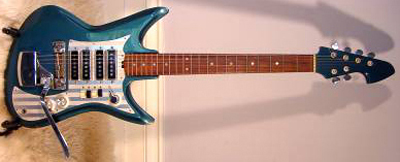
Teisco Serial Number Dating

Few non-American guitar brands have meant so much to so many American guitar buffs as Teisco guitars. Indeed, through their mid-’60s connection with the Sears and Roebuck company, many a modern guitar player learned his or her first chops on a Silvertone made in Japan by the Teisco company. Nevertheless, for years Teiscos were the object of ridicule, the penultimate examples of “cheap Japanese guitars” (a reputation more based on cultural chauvinism than objective analysis, truth to tell). Even Dan Forte, who essentially began the category of writing about off-brand guitars (and who has given me many an entertaining moment in my life), chose Teisco Del Rey as his nom de plume, with more than a little tongue-in-cheek humor in the selection, no doubt.
Times change, of course, and so do perceptions. No longer regarded with complete disdain, Teisco guitars which not that many years ago retailed for $59 are now fetching upwards of $300 for certain models, as much as $1500 for the coveted Teisco Del Rey Spectrum 5s. With the renewed interest in these humble guitars growing, I thought it might be time to turn our intention to the story of Tesico guitars.
A Reference For Dating Guitars Made by Fender Gibson Gretsch. Avoid any instruments where the serial number has been. SE Fender like models. The lower priced no serial number Greco Les. ConcernedThinker PRS, Gibson, Teisco, Peavey 0 points 1 point 2 points 1 year ago. And now we have this Korea-made guitar with a serial number of. Q: The serial number on my guitar/amp is????? When was it made? A: Identifying the exact age is usually impossible - no records were kept of serial numbers and manufacture dates. If you read the 'Timeline' page then you should be able to make a rough guess.
Source Code Aplikasi Penjualan Barang (POS Kasir Minimarket) – Source code aplikasi penjualan barang atau bisa kita kenal dengan nama POS (point of sale) adalah sebuah program atau aplikasi kasir yang digunakan untuk mengelola dan memanagemen produk barang yang dijual pada bisnis minimarket anda. Source code aplikasi penjualan barang kasir.
Before we begin, it should be pointed out that some time ago Guitar Player presented the history of Teisco, based on information painstakingly translated from a Japanese article penned by Mr. Hiroyuki Noguchi of Japan’s Rittor Music, editor of the Guitar Graphic book series. Unfortunately, the article used for reference was an older piece which has subsequently been totally revised and corrected by Mr.
Noguchi based on later interviews with principals in the Teisco company. Some of the chronology in the GP story is inaccurate. What follows here is the latest and most accurate information on Teisco (in regards to company history), confirmed in repeated direct communications with Mr. Noguchi in Japan. This information also supersedes some incorrect facts in my own essay on Teisco Del Rey Spectrum 5 guitars in the first issue of Vintage Guitar Classics. By the way, if you like older Japanese guitars, you must obtain a copy of Mr.
Noguchi’s book, ’60s Bizarre Guitars (Guitar Magazine Mooks, Rittor Music). It is lusciously printed in color and, while the text is in Japanese, model names and dates are in English, so it is an invaluable reference tool, as well as a fun coffee table book. Some of the following information on specific guitars comes from this source, as well as catalogs and other research materials kindly provided by dedicated guitar fans in both the U.S. It’s virtually impossible to reconstruct a comprehensive chronology, but we will attempt to document some broad-brush details and periods of what guitars we can, and with luck you’ll be able to search out and identify your favorite Teiscos with much greater authority. Your corrections and additions are most welcome! The Name Game First of all, let’s clear up some minor confusion over the name.
It has been variously reported, including by me, that the name “Teisco” stands for the name of a company in Tokyo; however this is not the case. Teisco was simply the name chosen by one of the company’s founders, Mr. Atswo Kaneko. There was another prominent company called the Tokyo Sound Co., Ltd.